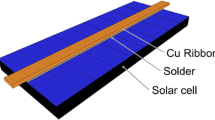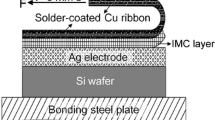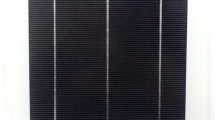Abstract
In this study, solar ribbon solder joints were investigated to ensure the reliability of photovoltaic (PV) modules. Ribbon joints comprising two different solder compositions (wt. %: 60Sn40Pb, 62Sn36Pb2Ag) were used to perform thermal aging tests at three different temperatures (150 °C, 120 °C, and 90 °C) during a 1000-h period to analyze the resultant thermal degradation; shear tests were also performed to measure bond strengths. Initial bond strengths were 271.3 MPa and 241.3 MPa for 62Sn36Pb2Ag and 60Sn40Pb solder joints, respectively. Bonding strength decreased as a result of thermal aging, but was maintained at a value of around 130 MPa regardless of solder composition. Fracture surfaces from the shear test were observed to analyze for the constant bond strength phenomenon. It was verified that the shear fracture surface changed from the solder/sintered Ag interface and the sintered silver (Ag)/silicon (Si) wafer interface during thermal aging. Thus, the bond strengths and bonding characteristics of PV ribbon solder joints decreased under a thermal load, which could be attributed to a weakening of the bonding characteristics for sintered Ag silicon interfaces as opposed to a degradation of solder metallurgy.









Similar content being viewed by others
References
Ren21, Renewables. (2010). “Global status report.” In Renewable Energy Policy Network for the 21st Century, Paris, France (pp. 1–80).
Kirkegaard, J. F., et al. (2010). “Toward a sunny future? Global integration in the solar PV industry.” In Peterson institute for international economics working paper 10-6 (pp. 1–66).
Branker, K., Pathak, M. J. M., & Pearce, J. M. (2011). A review of solar photovoltaic levelized cost of electricity. Renewable and Sustainable Energy Reviews, 15(9), 4470–4482.
Bhandari, B., et al. (2015). Optimization of hybrid renewable energy power systems: A review. International Journal of Precision Engineering and Manufacturing-Green Technology, 2(1), 99–112.
Kim, J.-H., et al. (2015). Review of nanocellulose for sustainable future materials. International Journal of Precision Engineering and Manufacturing-Green Technology, 2(2), 197–213.
Bhandari, B., et al. (2017). Socio-economic impact of renewable energy-based power system in mountainous villages of Nepal. International Journal of Precision Engineering and Manufacturing-Green Technology, 4(1), 37–44.
Green, M. A. (2016). Commercial progress and challenges for photovoltaics. Nature Energy, 1, 15015.
Geipel, T., et al. (2016). A comprehensive study of intermetallic compounds in solar cell interconnections and their growth kinetics. Energy Procedia, 98, 86–97.
Xu, L., et al. (2005). Isothermal and thermal cycling aging on IMC growth rate in lead-free and lead-based solder interface. IEEE Transactions on Components and Packaging Technologies, 28(3), 408–414.
Pang, J. H. L., et al. (2004). Thermal cycling aging effects on Sn–Ag–Cu solder joint microstructure, IMC and strength. Thin Solid Films, 462, 370–375.
So, A. C. K., & Chan, Y. C. (1996). Aging studies of Cu-Sn intermetallic compounds in annealed surface mount solder joints. In Proceedings., 46th. IEEE Electronic Components and Technology Conference.
Lee, Hwa-Teng, & Chen, Ming-Hung. (2002). Influence of intermetallic compounds on the adhesive strength of solder joints. Materials Science and Engineering A, 333(1), 24–34.
Kang, M.-S., et al. (2016). Degradation characteristics and Ni3Sn4 IMC growth by a thermal shock test in SAC305 solder joints of MLCCs applied in automotive electronics. International Journal of Precision Engineering and Manufacturing, 17(4), 445–452.
Kang, M.-S., et al. (2015). Evaluation of the characteristics of 305SAC lead-free solder joints between a chip electrode and a Cu-pad in automotive electronics. International Journal of Precision Engineering and Manufacturing, 16(12), 2483–2490.
Yang, T. L., et al. (2014). Growth kinetics of Ag 3 Sn in silicon solar cells with a sintered Ag metallization layer. Solar Energy Materials and Solar Cells, 123, 139–143.
Hsieh, H.-H., et al. (2013). An innovative packaging process for low power loss solar modules. In 2013 8th International Microsystems, Packaging, Assembly and Circuits Technology Conference (IMPACT). IEEE.
Frear, D. R. (1990). Microstructural evolution during thermomechanical fatigue of 62Sn-36Pb-2Ag and 60Sn-40Pb solder joints. IEEE Transactions on Components, Hybrids, and Manufacturing Technology, 13(4), 718–726.
Li, D., Liu, C., & Conway, P. P. (2005). Characteristics of intermetallics and micromechanical properties during thermal ageing of Sn–Ag–Cu flip-chip solder interconnects. Materials Science and Engineering A, 391(1), 95–103.
Miao, H.-W., & Duh, J.-G. (2001). Microstructure evolution in Sn–Bi and Sn–Bi–Cu solder joints under thermal aging. Materials Chemistry and Physics, 71(3), 255–271.
Standard, J. E. D. E. C. (2004). High temperature storage life: JESD22-A103C. Arlington: JEDEC Solid State Technology Association.
Deng, X., et al. (2005). Influence of reflow and thermal aging on the shear strength and fracture behavior of Sn-3.5 Ag solder/Cu joints. Metallurgical and Materials Transactions A, 36(1), 55–64.
Pang, J. H. L., et al. (2001). Thermal cycling aging effects on microstructural and mechanical properties of a single PBGA solder joint specimen. IEEE Transactions on Components and Packaging Technologies, 24(1), 10–15.
Dutta, I., et al. (2005). Effect of thermo-mechanically induced microstructural coarsening on the evolution of creep response of SnAg-based microelectronic solders. Materials Science and Engineering A, 410, 48–52.
Zhang, J., et al. (2013). Thermal aging effects on the thermal cycling reliability of lead-free fine pitch packages. IEEE transactions on components, packaging and manufacturing technology, 3(8), 1348–1357.
Haynes, W. M. (Ed.). (2014). CRC handbook of chemistry and physics (p. 89). Boca Raton: CRC Press.
Luo, Y.-R. (2007). Comprehensive handbook of chemical bond energies (p. 475). Boca Raton: CRC Press.
Takemoto, T., Matsunawa, A., & Takahashi, M. (1997). Tensile test for estimation of thermal fatigue properties of solder alloys. Journal of Materials Science, 32(15), 4077–4084.
Yan, Y. F., et al. (2010). Effect of Ag particles on wettability and creep rupture life of SnCu based composite solders. Materials Science Forum, vol. 650. Trans Tech Publications.
Huh, S.-H., Kim, K.-S., & Suganuma, K. (2001). Effects of Ag addition on the microstructural and mechanical properties of Sn–Cu eutectic solder. Materials Transactions, 42(5), 739–744.
Kang, M. S., Jeon, Y. J., Kim, D. S., & Shin, Y. E. (2017). Comparison of the 60Sn40Pb and 62Sn36Pb2Ag solders for a PV ribbon joint in photovoltaic modules using the thermal shock test. Energies, 10(4), 529.
Tomlinson, W. J., & Fullylove, A. (1992). Strength of tin-based soldered joints. Journal of Materials Science, 27(21), 5777–5782.
Acknowledgements
This research was supported by the Chung-Ang University research Grant in 2017.
Author information
Authors and Affiliations
Corresponding author
Additional information
Publisher's Note
Springer Nature remains neutral with regard to jurisdictional claims in published maps and institutional affiliations.
Rights and permissions
About this article
Cite this article
Kang, MS., Jeon, YJ. & Shin, YE. Bonding Strengths and Thermal Degradation of Photovoltaic Module Ribbon Solder Joints. Int. J. of Precis. Eng. and Manuf.-Green Tech. 6, 489–496 (2019). https://doi.org/10.1007/s40684-019-00045-0
Received:
Revised:
Accepted:
Published:
Issue Date:
DOI: https://doi.org/10.1007/s40684-019-00045-0




